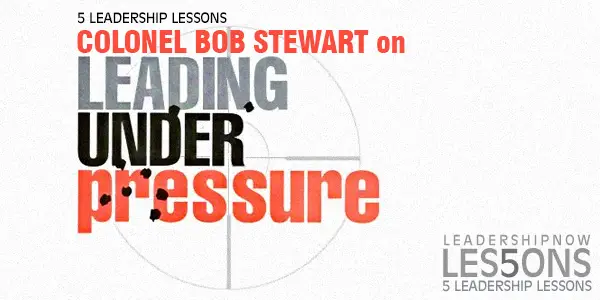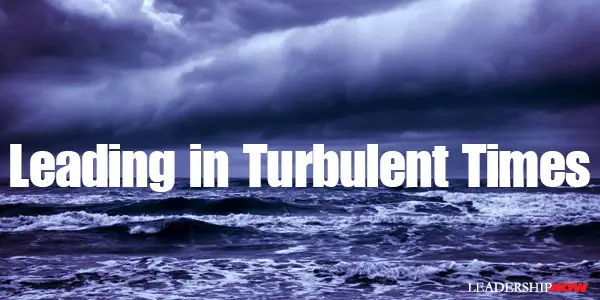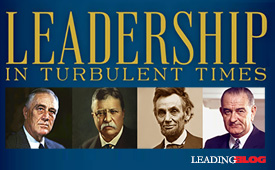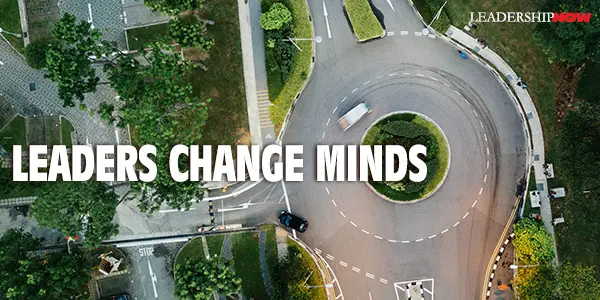 Leading Blog | Posts by Month |
 Leading Blog | Posts by Month |
03.31.10

LeadershipNow 140: March 2010 Compilation
See more on
Posted by Michael McKinney at 10:11 AM
03.30.10

Leading Views: The Leader as Communicator
Speech is a part of manners, and the able businessman must learn to express himself in English which is clear as well as colloquial.
Posted by Michael McKinney at 07:33 AM
03.29.10

Your Brain at WorkDavid Rock (now Dr. Rock) says, “Your capacity to change yourself, change others, and even change the world, may boil down to how well you know your brain, and your capacity to consciously intervene in otherwise automatic processes.” His book, Your Brain at Work helps give you the terminology you need to understand the everyday brain functions we experience.The book tells the story of Emily and Paul, the parents of two young children. Emily is a newly promoted executive in a large corporation, while Paul has his own business as a consultant. We travel inside Emily and Paul’s brains as they attempt to sort the vast quantities of information they’re presented with, figure out how to prioritize it, organize it and act on it. Woven into the story are 14 different challenges we all face like overwhelming email, multitasking, distractions, roadblocks, uncertainty and relationships. Rock looks at the tasks Emily and Paul faced how they handled them and then discusses what brain research says about what the brain is trying to do in each situation. Concluding each chapter is a Take Two. Here we get to see how they might have handled things differently with the brain in mind. It is amazing how just small changes in how we do a task or view a situation can have dramatic effects on our well-being, resolve and/or productivity. Doing the Right Tasks at the Right Time and in the Right Way There is a lot to learn here. For example, our conscious thinking brain resources located in the prefrontal region are less plentiful than we might think. We are only at our best from a brain perspective, for a small part of the day and we often don’t use these resources wisely, wasting them on low-level activities like answering e-mail. What we need to do is to develop a greater degree of cognitive control. People who seem to have frequent insights do not do so by focusing harder on the problem, instead they have learned to switch off their thinking – to access a quieter mind on demand. Having insights involves hearing subtle signals and allowing loose connections to be made by quieting the mind – letting the brain idle with minimal electrical activity.
Posted by Michael McKinney at 06:49 AM
03.25.10

5 Leadership Lessons: Colonel Bob Stewart on Leading Under Pressure
Leadership Under Pressure is a book of lessons learned and shared in personal stories by Colonel Bob Stewart. He was the first British United Nations Commander in Bosnia. On return from Bosnia Stewart was awarded the Distinguished Service Order for “cool courage and inspirational leadership.” Stewart believes that leadership is universal and is not confined to a few special people. “It is universal, normal and quite ordinary too…. Leading in its basic form is the ability to show the way and guide others to achieve something.” Here are just several of the lessons he presents:

Posted by Michael McKinney at 02:09 PM
03.23.10

Leading in Turbulent Times
I THINK Victor Fung of the Li and Fung Group (the Chinese multinational founded in Guangzhou in 1906) summed up well the sense of the kind of change we face today: A lot of people say, hey, this is a once in a century type of problem. We haven’t had anything like this since the 1930s. You hear all these statements, and they seem to imply that this is once in a lifetime after I get through this one, boy, am I glad I will never have to face this again. But I’m not so sure. I think we are seeing both the compression of cycle time – how quickly the cycles come and go – and also the amplitude of the swings getting more and more severe. The world has fundamentally changed. I think we all understand that this type of change requires a special kind of leadership. Kevin Kelly and Gary Hayes have collected in Leading in Turbulent Times the lessons learned from over thirty CEOs, Chairmen and other senior executives who are prevailing in spite of a challenging environment. It’s a valuable look at how some frontline leaders are finding the right balance between seizing the opportunities as they present themselves and managing the accompanying risk. Rather than typical conversations focused on financial matters, Kelly and Hayes found that three strong messages emerged from their interviews: Passion Rules – these leaders are driven by a real passion for their business, their organization and the people they work with. Hard Times Call for a Mastery of Soft Skills - especially communication but also empathy, mentoring and coaching. (“This is a timely reminder that cost control is a business basic, but extracting great performance from people is always based on more complex and subtle motivational tools than pure fear.”) A CEO in Germany observed that whenever a leader talks about change, employees always expect the worse. Learning to motivate and engage people in spite of the crisis becomes critical. Think Long Term – these leaders refuse to bow under immediate pressure. They use short-term pressures to harden their focus on long-term objectives. Infosys CEO Kris Gopalakrishnan says, “We need to be much more flat, creating a collegial team-based leadership style so that you can leverage a lot more of people’s intellects and capabilities and make them participate in decision making.” This requires a level of social skills that haven’t been demanded of leaders in the recent past and so I imagine this necessitates a lot of learning-as-we-go. At the same time, we have a more educated workforce that brings with it other issues that require fresh approaches. Henry Fernabdez, CEO of MSCI Barra observed, “They figure things out very quickly. They tend to be more open to change but, on the other hand, they’re smart and can become cynical and harder to change.” As a result, the job of leadership is changing. Through revealing and personal interviews, Kelly and Hayes have analyzed the current situation beginning with how to recognize the early signals, mobilizing people to act, navigating a new course, preventing "mutinies" by engaging the resistors and learning to be flexible in the face of the unpredictable. To live in these turbulent conditions requires that you dig deep. Leaders need to develop and constantly improve; a deeper self-knowledge; new perspectives. As they note, this isn’t easy. “It is a bit like trying to get fit when you are in the middle of a title fight.” A positive mental attitude is critical says Mark Frissora of Hertz: The shadow of a leader is huge so it is very important that we walk out of this room with smiles on our faces, and talk about the opportunities. We need discipline, but at the same time, we need to make sure that we always put a positive frame of reference on everything we’re doing.   
Posted by Michael McKinney at 11:14 PM
03.18.10

Leaders Change Minds
ROSABETH MOSS KANTER (Evolve!/2001) likens the constant change happening today to the croquet game in Alice in Wonderland, a game in which “nothing remains stable for very long, because everything is alive and changing.” Robert Kriegel adds, “Not only is everything changing, but everything exists in relationship to something else that is changing." He suggests, "If you or your products don't grow, improve and evolve, as in nature—they (and you) will face extinction.” Faced with this understanding, we quite often either freeze and do nothing or go into a frenzy and begin to change everything. Certainly, change must become a part of our orientation. However, the changes must be calculated changes and not a reaction to perceived pressures or change based on the shallow "new-is-better" mindset. As part of our ongoing maintenance (and it should be ongoing)—personally and organizationally—we must take a look at what should not be changed (and some things shouldn't) and what might, could or should be changed. Core values don't change, but methods (approaches) often do. If these things are not considered in advance, the tendency will be to make rash and impulsive moves from one ditch to the other when the pressure to change begins to loom over us. Change has become the mantra for leaders. We often feel the need to move into a situation and shake it up … because then we’re really leading. And if we are not careful, we can get into a change for change’s sake mindset. If something doesn’t change, we aren’t doing our job. But we must remember that when talking about change in a leadership context, we are talking about changing people—their minds—and situations only indirectly. Leaders change conditions through people. Sometimes, the change we need is to get people to hold on—to stay the course—when they would feel like giving up, changing direction or abandoning the mission. Sometimes the status quo is exactly what is called for, and changing people’s minds and perspectives to see that need is the leader’s task. Sometimes, the change we need may indeed look on the outside like no change at all. But it is change just the same. Sometimes our yardstick is not how different it looks but how consistent it is. That takes a lot of changing.
Posted by Michael McKinney at 09:46 AM
03.10.10

How to Decommoditize Your LeadershipAll leaders want to make a difference; be transformational. And some do and some really don’t. We’ve all known leaders that are easily replaced. And (hopefully) we’ve known some that we can’t imagine doing without.The difference begins with the bond we create by integrating who we are with what we do. Making a difference has a lot to do with how completely we integrate what we are (our character, values and attitudes) with what we do (our competencies). All leaders have to set direction, give orders, and display competence. But if that’s all they’re doing, they’re replaceable. What sets one leader apart from another, what makes an order compelling rather than coercive, is the kind of spirit that accompanies their actions; a commanding what-can-I-get-from-them approach or a servant what-can-I-give-them value system. But either way, what makes us take notice is their authenticity—their uniqueness. Are they being themselves or worse still, trying to be something they’re not? It is in the visible world that our “invisible” inner world is manifested. When we integrate our whole person, we create the potential for meaning in our work, trust with those we lead, and in turn, we build our uniqueness as a leader. In Rework, they write about building uniqueness in a business: “If you’re successful, people will try to copy what you do. It’s just a fact of life. But there’s a great way to protect yourself from copycats: Make you part of your product or service. Inject what’s unique about the way you think into what you sell. Decommoditize your product. Make it something no one else can offer.” The same is true on an individual level. You are your product. When you put more of you into the equation, you make yourself unique—even indispensable. When you add in humility, you create meaning that people can get behind. [In Seth Godin parlance: Indispensable + Humility = a Linchpin you can live with]
Posted by Michael McKinney at 05:25 PM
03.09.10

Get to the Why by Starting at the EpicenterWhen beginning or introducing anything—an idea, a project, or a new venture—you need to start with asking yourself why. In Rework, authors Jason Fried and David Heinemeier Hansson write candidly about where to begin:When you start anything new, there are forces pulling you in a variety of directions. There’s stuff you could do, the stuff you want to do, and the stuff you have to do. The stuff you have to do is where you should begin. Start at the epicenter.They suggest you begin by asking, “If I took this away, would what I’m selling still exist?” It’s easy to get bogged down in the details and get off on tangents. And while details are important, they can distract you, pulling you in the wrong direction or even derail your idea. They caution: “Getting infatuated with details too early leads to disagreement, meetings, and delays. You get lost in things that don’t really matter. You waste time on decisions that are going to change anyway. So ignore the details—for a while. Nail the basics first and worry about the specifics later.”
Posted by Michael McKinney at 11:31 PM
03.05.10

Becoming A LinchpinLinchpin is about personal leadership and is the most leadership oriented book Godin has written to date. He makes a good case for developing yourself to reach your potential against the backdrop of the changing workplace. Changing workplace or not, it is the thing to do.In the industrial workplace it was easier, even expected that you could hide behind your job in exchange for job security. “You weren’t born to be cog in the giant industrial machine. You were trained to become cog.” (His assessment of our educational system is spot on.) Today successful companies are looking for people who make a difference—linchpins. “Linchpins are the essential building blocks of tomorrow’s high-value organizations. They don’t bring capital or expensive machinery, nor do they blindly follow instructions and merely contribute labor.” Linchpins don’t worry about what’s in it for them, but instead focus on giving gifts that change people. They can see the reality of today and describe a better tomorrow. That is, if they can ignore that voice inside that tells them to keep their head down, don’t make waves, don’t stand out. Godin identifies that voice as your lizard brain. Overcoming the lizard brain takes training. “In the face of greed or fear from the amygdala [a-MIG-da-la or lizard brain], an untrained person surrenders.” “The goal,” says Godin, “is to quit the tasks you’re doing because you’re hiding on behalf of the lizard brain and to push through the very tasks the lizard fears.” He notes, “Ironically, it’s those who seek out discomfort that are able to make a difference and find their footing.” The good news is that this doesn’t necessarily mean you need to change your job, your boss or your co-workers. That wouldn’t solve your problem anyway. The problem rests with you—your attitude. The difference between a cog and a linchpin really comes down to attitude. It requires a change of attitude. It means choosing to do your old job in a new way. A choice to not hide your best work. A choice to find your opportunities to make something happen. A choice to overcome the resistance you face in doing your work because what you have to offer is important enough to make the effort. The subtitle of the book asks, “Are you indispensable?” When talking about being indispensable, we need to distinguish between your value and your attitude. By developing your unique gifts—becoming more of who you are—you are increasing your value, exposing your gifts, and making yourself indispensable in a “there is no one like you” sense. That’s different than thinking you are indispensable. That’s an attitude that will lead you to self-destruction. (Mike Myatt expresses well the pitfalls of that kind of thinking.) I don’t think Godin is advocating arrogance or parading a “you can’t do without me" attitude. Instead, he is advocating that we make the choice to develop our unique combination of gifts and give them to the world in a way that makes a difference—to change people’s lives with what is the indispensable contribution that every human being can make if they will but choose to overcome the resistance to play it safe and aim for average.
Posted by Michael McKinney at 01:30 AM
03.02.10

Leading Views: Structure Formally, but Work Informally In The Right Fight, authors Saj-nicole Joni and Damon Beyer explain that in order for a leader to receive reliable information they need to go outside the constructs of the formal organization:
In The Right Fight, authors Saj-nicole Joni and Damon Beyer explain that in order for a leader to receive reliable information they need to go outside the constructs of the formal organization:
Great leaders learn how to work out tensions and conflicts through the informal networks that make the formal organization hum. They acknowledge their need for access to unfiltered information and recognize the creative potential in opportunities for unfettered thinking. They leverage their personal and expertise-based relationships in the informal organization to gather information, to gauge employee morale and mood, to allow things to bubble up from the best and the brightest, to test hunches, and to champion ideas. Beyond that, they set up systems that encourage everyone to participate in the informal knowledge sharing, creating an open culture radically unlike the “mushroom” environment of far too many companies—where the lower an employee is on the org chart, the more likely he is to be kept in the dark.
Posted by Michael McKinney at 06:33 PM
03.01.10

First Look: Leadership Books for March 2010Here's a look at some of the best leadership books to be released in March.




For bulk orders call 1-800-423-8273
Posted by Michael McKinney at 09:07 AM

Build Your Leadership Library Build your leadership library with these specials on over 180 titles. All titles are at least 40% off the list price and are available only in limited quantities.
Posted by Michael McKinney at 09:06 AM
|
BUILD YOUR KNOWLEDGE


How to Do Your Start-Up Right STRAIGHT TALK FOR START-UPS 
Grow Your Leadership Skills NEW AND UPCOMING LEADERSHIP BOOKS 
Leadership Minute BITE-SIZE CONCEPTS YOU CAN CHEW ON 
Classic Leadership Books BOOKS TO READ BEFORE YOU LEAD |
|